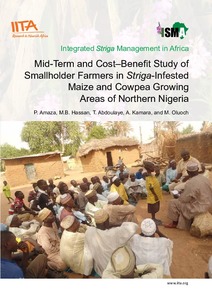| dc.contributor.author | Amaza P. |
| dc.contributor.author | Hassan, M.B. |
| dc.contributor.author | Abdoulaye, Tahirou |
| dc.contributor.author | Kamara, A. |
| dc.contributor.author | Oluoch. M. |
| dc.date.accessioned | 2019-12-04T11:08:17Z |
| dc.date.available | 2019-12-04T11:08:17Z |
| dc.date.issued | 2014 |
| dc.identifier.citation | Amaza P., Hassan, M.B., Abdoulaye, T., Kamara, A. & Oluoch. M. 2014. Mid-term and cost-benefit study of smallholder farmers in Striga-Infested maize and cowpea growing areas of Northern Nigeria.Ibadan, Nigeria: IITA. 1-41. |
| dc.identifier.isbn | 978-978-8444-52-7 |
| dc.identifier.uri | https://hdl.handle.net/20.500.12478/1783 |
| dc.description.abstract | The Bill and Melinda Gates Foundation (BMGF) provided a 4-year financial support to the International Institute for Tropical Agriculture (IITA) and other partners in 2011 to adapt and intensively promote proven integrated
Striga management strategies in cowpea and maize farming systems in northern Nigeria and western Kenya, with the active participation of farmers, community-based organizations, extension workers, policy makers, and
researchers. The objective of the project is to improve the livelihoods of over 25 million smallholder farmers in the immediate impact zones of the project in northern Nigeria (15 million) and western Kenya (10 million) in the long term by developing and implementing a robust “ Striga threat reduction strategy” that identifies and strategically promotes scientifically proven technologies that work on smallholder farmers’ fields and which have direct effects on stopping Striga emergence, reducing the Striga seed bank in the fields, improving soil fertility, and increasing crop yields.
The management technologies being promoted in Northern Nigeria range from cultural practices such as crop rotation of maize with soybean which stimulates Striga to germinate but which later dies in the absence of the maize host to latch onto; and using Striga-resistant maize and cowpea varieties.
The ISMA project is expected to end in 2015, thus, it is pertinent to carry out a mid-term evaluation of the project with respect to adoption and benefit-cost analysis of the Striga management technologies among farming households in the project areas and make a comparison with non-intervention areas. In Nigeria, the Integrated Striga Management in Africa (ISMA) project was implemented in Kano and Bauchi states, both located in the savanna agroecology of northern Nigeria. The mid-term evaluation will provide the basis to present ISMA’s achievement to policy makers, NARES, private sector partners, the BMGF, and other development partners. The result will also guide the scaling-up and scaling out of the project to other parts of the savanna ecological zones of northern Nigeria. It is within this context that the study was planned. The objectives of the study were to... |
| dc.description.sponsorship | Bill & Melinda Gates Foundation |
| dc.format.extent | 1-41. |
| dc.language.iso | en |
| dc.subject | Smallholders |
| dc.subject | Maize |
| dc.subject | Cowpeas |
| dc.subject | Northern Nigeria |
| dc.subject | Striga Hermonthica |
| dc.title | Mid-term and cost-benefit study of smallholder farmers in Striga-Infested maize and cowpea growing areas of Northern Nigeria |
| dc.type | Book |
| dc.description.version | Peer Review |
| cg.contributor.crp | Grain Legumes |
| cg.contributor.crp | Maize |
| cg.contributor.affiliation | International Institute of Tropical Agriculture |
| cg.coverage.region | Africa |
| cg.coverage.region | West Africa |
| cg.coverage.country | Nigeria |
| cg.authorship.types | CGIAR single centre |
| cg.iitasubject | Cowpea |
| cg.iitasubject | Maize |
| cg.journal | Integrated Management in Africa |
| cg.howpublished | Formally Published |
| cg.accessibilitystatus | Open Access |
| local.dspaceid | 83235 |

